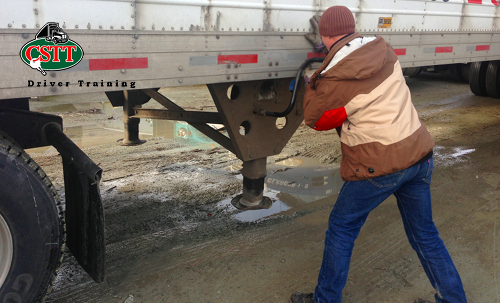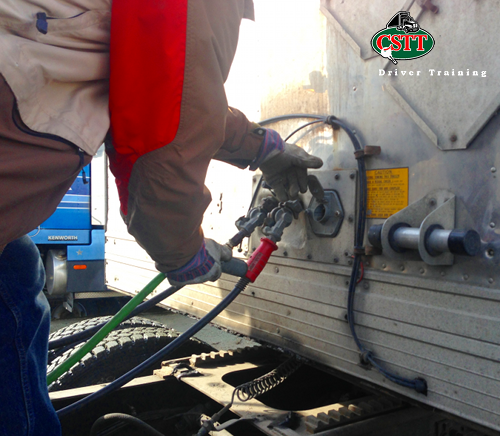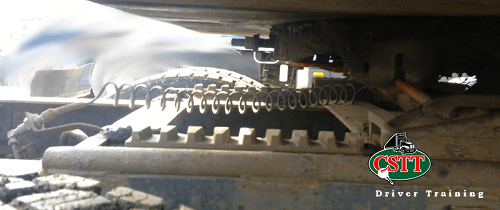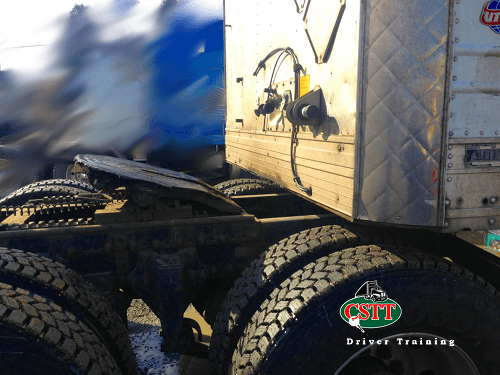Unhooking a semi-trailer – how to unhook a semi trailer
January 12, 2015
For veteran truck drivers, hooking and unhooking a trailer sometimes occurs several times a day. For others, they may only drop & hook once or twice a week, or rarely. Despite the ease with which trailers hook and unhook from a tractor, errors still occur.
All too often, trailers are dropped on the ground incurring considerable time and expense. A crane or large forklift first has to be found, brought to the site and used to pick up the trailer while the tractor backs under. Worse yet, the trailer falls off the back of the truck as it’s going down the road, risking the lives of other road users.
Unhooking or uncoupling – Simplified
Park the trailer in a safe & preferably secure location. A safe location is ideally a place away from the flow or path of traffic. Attempt to park the trailer away from a roadway, or in a yard away from the main travel path of other vehicles – ie. employees’ vehicles, forklifts and other trucks.
| 1. | Ensure that the ground will support the weight of the trailer – if not, use planking under the dollies or find another location |
| 2. | If the trailer is equipped with an air suspension dump valve – empty the air suspension |
| 3. | Wind down the landing gear until it just touches he ground – stow the crank handle |
| 4. | Disconnect the air lines and electrical chord and stow in the dummy couplers or secure to the deck plate with a bungee chord |
| 5. | Pull the 5th wheel handle to release the jaws – preferably using a 5th wheel puller |
| 6. | Climb in the cab and move the tractor ahead 6 inches using “bull” or low gear |
| 7. | Stop the truck and dump (lower) the tractor’s air ride suspension |
| 8. | Move ahead slowly until the trailer just slides off the back of the 5th wheel – the trailer should be wholly supported by its landing gear and the truck frame still under the trailer (to catch an unstable trailer) |
| 9. | Stop the tractor, place transmission in neutral and set the parking brake |
| 10. | Get out of the cab and ensure that the ground is in fact supporting the weight of the trailer |
| 11. | Get back in the cab – remember to reflate the tractor’s air suspension – you’re done |
What could potentially go wrong
If you don’t inspect the integrity of the ground before dropping the trailer, it could potentially sink. If this happens, you—yes you the driver—will be held responsible for negligently dropping a trailer. As well, in the summer on hot asphalt a trailer’s landing gear could damage the paving. To prevent holes in the asphalt, use boards under the dolly pads. In some trailer yards, a strip of concrete is poured and the trailer’s dollies must be positioned on the concrete to prevent damage to the pavement.
Dumping the air ride suspension on a loaded trailer before disconnecting potentially prevents damage to the landing gear. Over time as a loaded trailer sits, the air ride suspension bleeds off. As the air ride suspension gradually deflates, the rear of the trailer sinks; consequently, forward pressure is exerted on the landing gear which potentially bends the legs and struts.
Always wind the landing gear down first, otherwise you may get distracted and forget. By establishing a procedure of doing the landing gear first, you will never risk potentially unhooking a trailer and dropping it on the ground.
Immediately after winding down the landing gear, disconnect the airlines and the electrical chord. If you wind down the
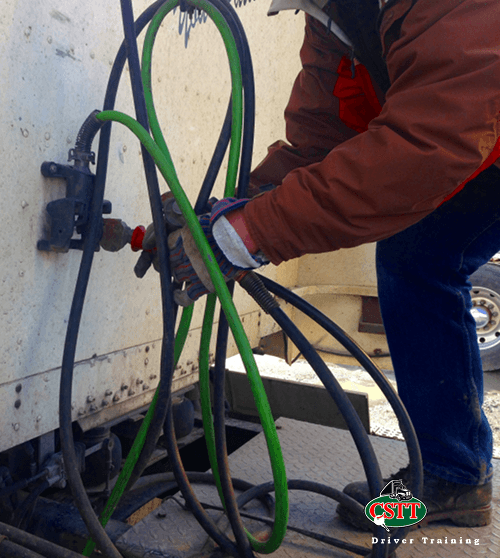
landing gear and then pull the 5th wheel pin, again, you may get distracted and forget to disconnect the lines. And believe me: there is nothing that will make you look more amateur than driving away from a trailer and snapping off the air lines and electrical chord.
- This error is tantamount to driving away from the fuel pump with the fill spout in your tank.
- Finally, if you wind down the landing gear and disconnect the lines, but forget to pull the pin, no one will know other than you. After a bit of embarrassment, you simply get out of the truck and pull the pin.
Before dumping the tractor’s air ride suspension, move the truck forward slightly to disengage the king pin from the 5th wheel jaws. The trailer’s king pin has a flange on the bottom, and if you lower the truck while the king pin is still inside the 5th wheel coupler, the connection jaws could potentially “hang up” on the king pin’s flange. If the 5thwheel “hangs up” on the king pin, it could damage both the king pin and the 5th wheel coupling mechanism. If this undue stress occurs regularly, the 5th wheel may fail altogether.
Finally, don’t just pull out from under the trailer and drive away. If you pull out only far enough that the trailer comes off the back of the 5thwheel and stop, you can still get the tractor back under the trailer if the ground doesn’t support it. Otherwise, if you pull the tractor out and the trailer sinks, a crane or heavy fork truck will be required to get the trailer back up to a level that it can be hooked to a truck.
Summary
- Pull out from the trailer until it just comes off the back of the 5th wheel and stop – check to ensure that the ground is supporting the trailer and that the tractor’s frame is still available to catch the trailer if not stable
Unhooking a semi-trailer to a tractor is somewhat simple, if done in the above order with the proper checks. In the “real world of trucking” this procedure should take less than 5 minutes. If the above order is changed or the checks not completed, a trailer will likely end up on the ground at some point during your career. These precious minutes could potentially save you hours of grief and a reputation that will haunt your career.

